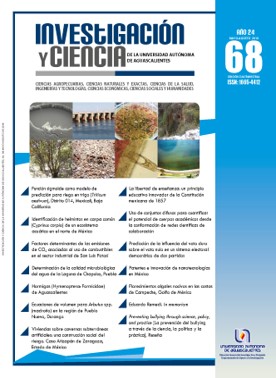Fuzzy sets implementation to quantify the potential for academic groups from the formation of scientific collaboration networks
DOI:
https://doi.org/10.33064/iycuaa2016682241Keywords:
academic groups, networks, fuzzy logic, fuzzy sets, institutional networks, knowledge generationAbstract
The establishment of networks of scientific collaboration of academic groups occurs like a strategic element for the generation and dissemination of knowledge. It is in this sense that the analysis and study of these networks and their results are presented in an appropriate way, however, it is a complex and multidimensional phenomenon. This is why new methods and tools are required. This paper explores the theory of fuzzy logic as an element of analysis that allows to accurately distinguish in quantifying the potential of academic groups in a multidimensional way. It makes evident the greater potential of academic bodies that make scientific collaboration networks.
Downloads
References
• CARAYOL, N. y ROUX, P. Knowledge flows and the geography of networks: A strategic model of small world formation. Journal of Economic Behavior & Organization, 71(2): 414-427, 2009.
• CARAYOL, N. et al. Inefficiencies in a model of spatial networks formation with positive externalities. Journal of Economic Behavior & Organization, 67(2): 495-511, 2008.
• FLORES, L. y CAMARENA, M. Evaluación de programas públicos en el marco de la realidad social, metodología basada en la lógica difusa como instrumento para el análisis de fenómenos sociales. Revista Latinoamericana de Metodología de la Investigación Social-ReLMIS, 3(5): 8-23, 2013.
• FLORES PAYÁN, L. y GARCÍA BATÍZ, M. L. Evaluación de programas públicos mediante lógica difusa: el caso del Programa Hábitat. Política y Cultura, otoño 2013(40): 231-255, 2013.
• JACKSON, M. O. Social and economic networks. Princeton: Princeton University Press, 2008.
• JACKSON, M. O. The economics of social networks. En R. Blundell, W. Newey & T. Persson (Eds.), Proceedings of the 9th World Congress of the Econometric Society (1-56). Cambridge, UK: Cambridge University Press, 2005.
• JACKSON, M. O. y WOLINSKY, A. A strategic model of social and economic networks. Journal of Economic Theory, 71(1): 44-74, 1996.
• KOSSINETS, G. y WATTS, D. Origins of homophily in an evolving social network. American Journal of Sociology, 115(2): 405-450, 2009.
• LÓPEZ, A. et al. Descomposición de la pobreza multidimensional mediante el enfoque de conjuntos difusos: una aplicación para el México rural. Documento de trabajo del CIDE-División de Economía, 464, 2009.
• SALAS, I. y MURILLO, F. Las microinteracciones como el origen de las redes de cooperación. Revista Latinoamericana de Metodología de la Investigación Social, 4(7): 57-77, 2014.
• ZADEH, L. A. Fuzzy sets. Information and Control, 8(3): 338-353, 1965.
Downloads
Published
How to Cite
License
Las obras publicadas en versión electrónica de la revista están bajo la licencia Creative Commons Atribución-NoComercial-CompartirIgual 4.0 Internacional (CC BY-NC-SA 4.0)









